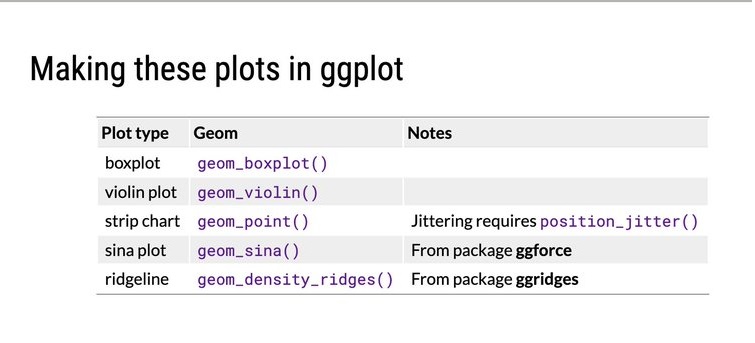第 32 章 ggplot2之科研数据可视化
32.1 统计分布图
在学术中,很多情形我们都需要画出统计分布图。比如,围绕天气温度数据(美国内布拉斯加州东部,林肯市, 2016年),我们想看每个月份里气温的分布情况
lincoln_df <- ggridges::lincoln_weather %>%
mutate(
month_short = fct_recode(
Month,
Jan = "January",
Feb = "February",
Mar = "March",
Apr = "April",
May = "May",
Jun = "June",
Jul = "July",
Aug = "August",
Sep = "September",
Oct = "October",
Nov = "November",
Dec = "December"
)
) %>%
mutate(month_short = fct_rev(month_short)) %>%
select(Month, month_short, `Mean Temperature [F]`)
lincoln_df %>%
head(5)## # A tibble: 5 × 3
## Month month_short `Mean Temperature [F]`
## <fct> <fct> <int>
## 1 January Jan 24
## 2 January Jan 23
## 3 January Jan 23
## 4 January Jan 17
## 5 January Jan 29统计分布图的方法很多,我们下面比较各种方法的优劣。
32.1.1 points-errorbars
画分布图的最简单的方法,就是计算每个月的气温均值或者中位数,并在均值或者中位数位置标出误差棒(error bars),比如图 32.1 。
lincoln_errbar <- lincoln_df %>%
ggplot(aes(x = month_short, y = `Mean Temperature [F]`)) +
stat_summary(
fun.y = mean, fun.ymax = function(x) {
mean(x) + 2 * sd(x)
},
fun.ymin = function(x) {
mean(x) - 2 * sd(x)
}, geom = "pointrange",
fatten = 5
) +
xlab("month") +
ylab("mean temperature (°F)") +
theme_classic(base_size = 14) +
theme(
axis.text = element_text(color = "black", size = 12),
plot.margin = margin(3, 7, 3, 1.5)
)
lincoln_errbar
图 32.1: 林肯市2016年气温变化图
但这个图有很多问题,或者说是错误的
图中只用了一个点和两个误差棒,丢失了很多分布信息。
读者不能很直观的读出这个点的含义(是均值还是中位数?)
误差棒代表的含义不明确(标准差?标准误?还是其他?)
通过看代码,知道这里用的是,均值加减2倍的标准差,其目的是想表达这个范围涵盖了95%的的数据。 事实上,误差棒一般用于标准误(或者加减2倍的标准误来代表估计均值的95%置信区间),所以这里使用标准差就造成了混淆。
( 标准误:对样本均值估计的不确定性; 标准差:对偏离均值的分散程度 )
- 现实的数据往往是偏态的,但这个图的误差棒几乎是对称,会让人觉得产生怀疑。
32.1.2 箱线图
为了解决以上问题,可以使用箱线图(boxplot),箱线图将数据分成若干段,如图 32.2.

图 32.2: 箱线图示意图
- 盒子中间的横线是中位数(50th percentile),底部的横线代表第一分位数(25th percentile),顶部的横线代表第三分位数(75th percentile)
- 盒子的范围覆盖了50%的数据,每个小盒子是25%的数据,盒子高度越短, 说明数据越集中,盒子高度越长,数据越分散。
- 上面的这条竖线的长度 = 从盒子上边缘开始,延伸到1.5倍盒子高度的范围中最远的点
- 下面的这条竖线的长度 = 从盒子下边缘开始,延伸到1.5倍盒子高度的范围中最远的点
- 在线条之外的点就是 outlies
那么气温分布用箱线图画出来 (图 32.3)。 我们可以看到12月份数据 偏态(绝大部分时候中等的冷,少部分是极度寒冷),其他月份,比如7月份,数据分布的比较正态
lincoln_box <- lincoln_df %>%
ggplot(aes(x = month_short, y = `Mean Temperature [F]`)) +
geom_boxplot(fill = "grey90") +
xlab("month") +
ylab("mean temperature (°F)") +
theme_classic(base_size = 14) +
theme(
axis.text = element_text(color = "black", size = 12),
plot.margin = margin(3, 7, 3, 1.5)
)
lincoln_box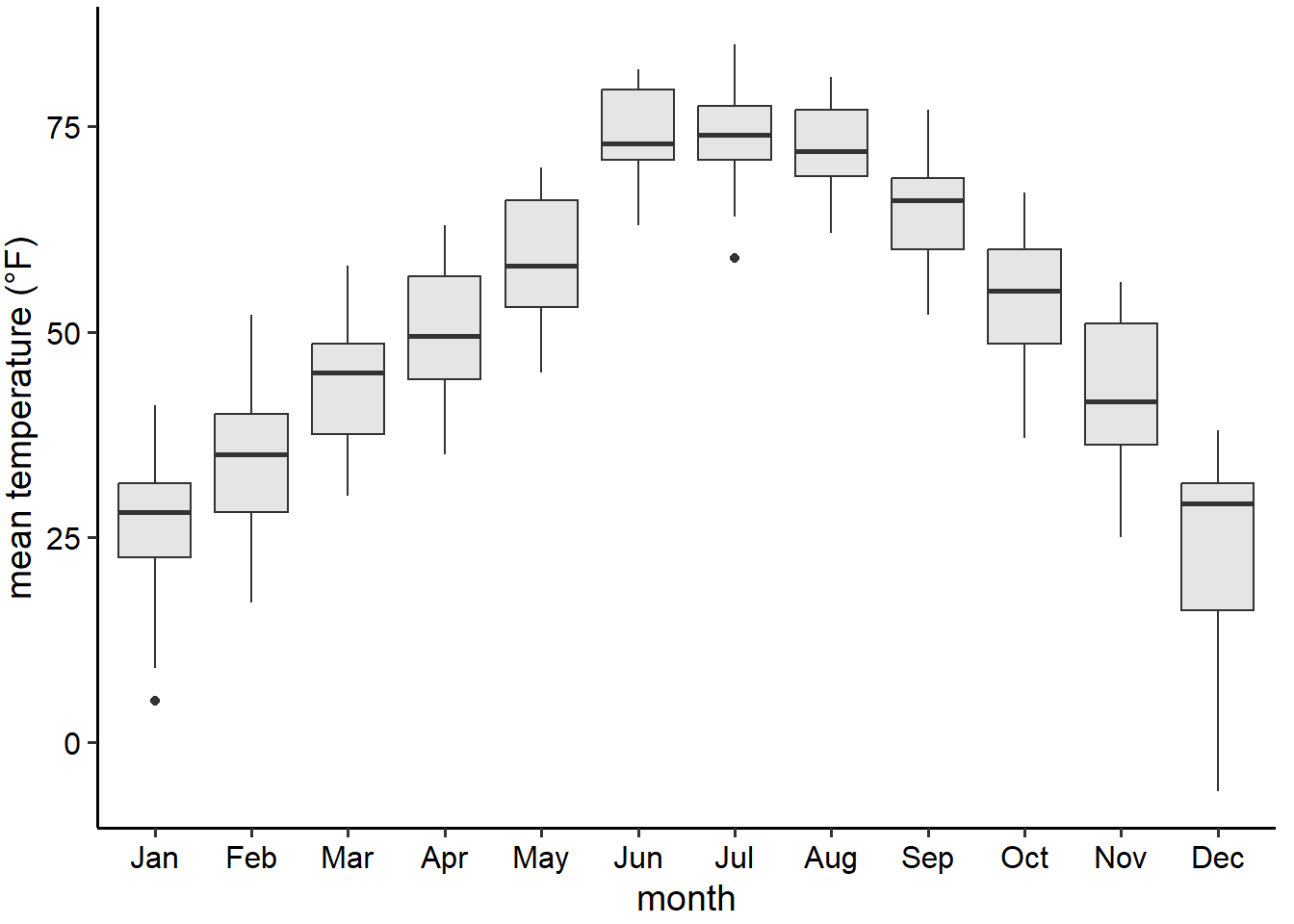
图 32.3: 林肯市2016年气温分布箱线图
32.1.3 小提琴图
箱线图是1970年代统计学家发明的一种可视化方法,这种图可以很方便地用手工画出,所以当时很流行,现在计算机性能大大提升了,所以大家喜欢用视觉上更直观的小提琴图取代箱线图

图 32.4: 小提琴图示意图
- 小提琴图相当于密度分布图旋转90度,然后再做个对称的镜像
- 最宽或者最厚的地方,对应着数据密度最大的地方
- 箱线图能用的地方小提琴图都能用,而且小提琴图可以很好的展示bimodal data的情况(箱线图做不到)

图 32.5: 图片来源:nature methods, VOL.11, NO.2, FEBRUARY 2014
在图 32.6, 我们使用小提琴图画图气温分布,可以看到,11月份的时候,有两个高密度区间(两个峰,50 degrees 和 35 degrees Fahrenheit),注意,这个信息在前面两个图中是没有的。
lincoln_violin <- lincoln_df %>%
ggplot(aes(x = month_short, y = `Mean Temperature [F]`)) +
geom_violin(fill = "grey90") +
xlab("month") +
ylab("mean temperature (°F)") +
theme_classic(base_size = 14) +
theme(
axis.text = element_text(color = "black", size = 12),
plot.margin = margin(3, 7, 3, 1.5)
)
lincoln_violin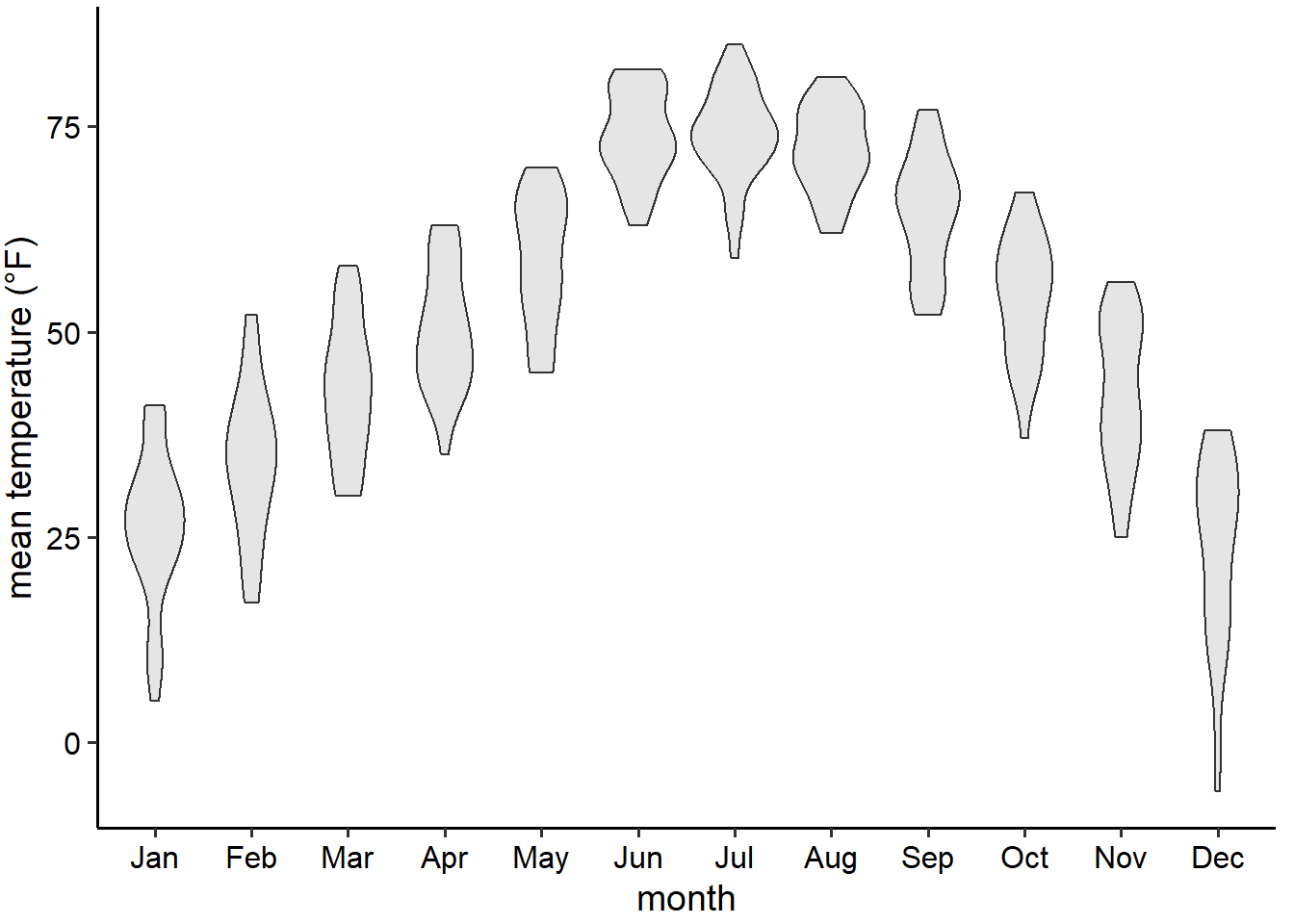
图 32.6: 林肯市2016年气温分布小提琴图
事实上,小提琴图也是不完美的,用的是密度分布图,会造成没有数据点的地方,也会有分布。怎么解决呢?
32.1.4 sina 图
解决办法就是,把原始数据点打上去,
lincoln_points <- lincoln_df %>%
ggplot(aes(x = month_short, y = `Mean Temperature [F]`)) +
geom_point(size = 0.75) +
xlab("month") +
ylab("mean temperature (°F)") +
theme_classic(base_size = 14) +
theme(
axis.text = element_text(color = "black", size = 12),
plot.margin = margin(3, 7, 3, 1.5)
)
lincoln_points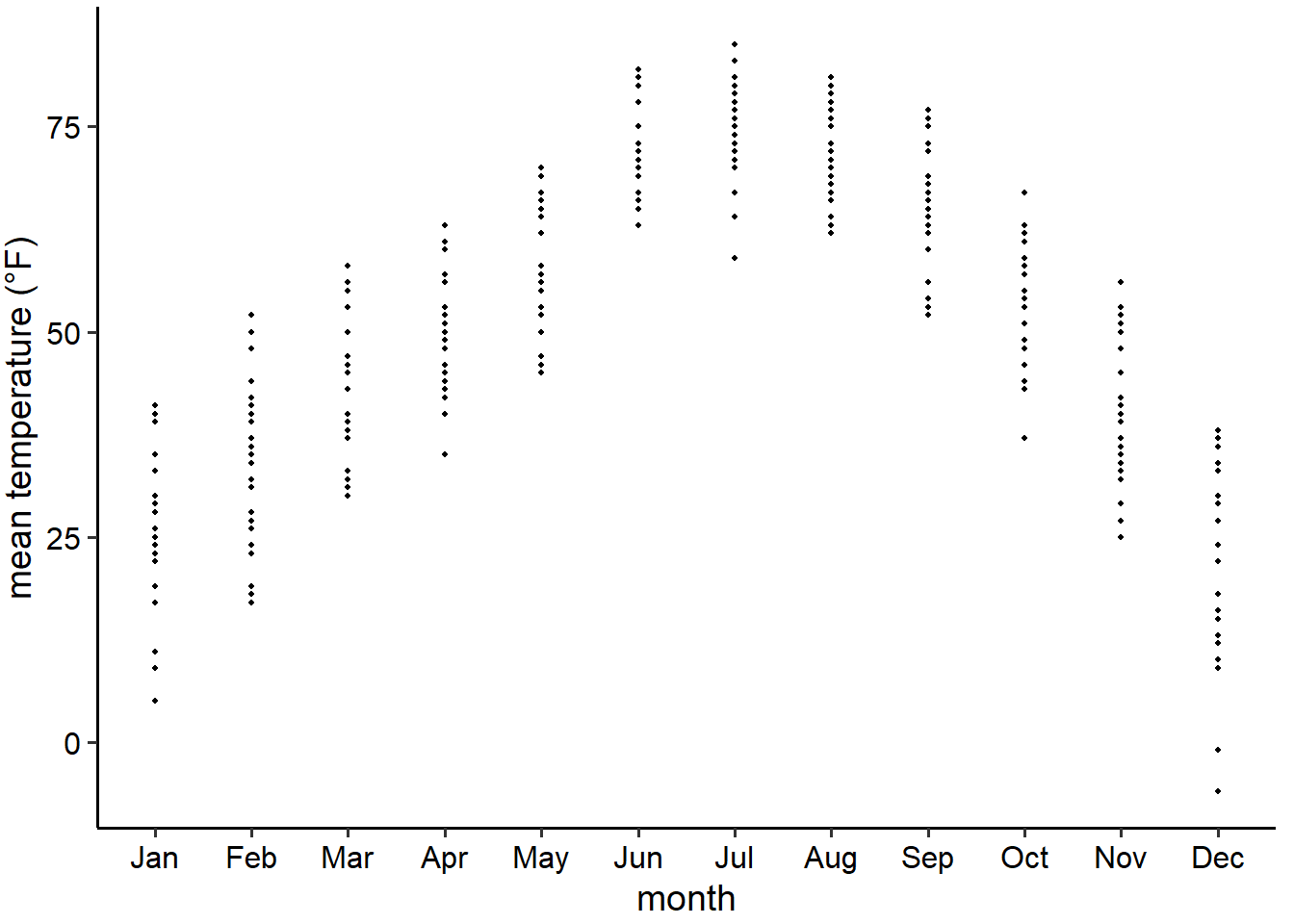
图 32.7: 林肯市2016年气温分布散点图
但问题又来了,这样会有大量重叠的点。有时候会采用透明度的办法,即给每个点设置透明度,某个位置颜色越深,说明这个位置重叠的越多。当然,最好的办法是,给每个点增加一个随机的很小的“偏移”,即抖散图。
lincoln_jitter <- lincoln_df %>%
ggplot(aes(x = month_short, y = `Mean Temperature [F]`)) +
geom_point(position = position_jitter(width = .15, height = 0, seed = 320), size = 0.75) +
xlab("month") +
ylab("mean temperature (°F)") +
theme_classic(base_size = 14) +
theme(
axis.text = element_text(
color = "black",
size = 12
),
plot.margin = margin(3, 7, 3, 1.5)
)
lincoln_jitter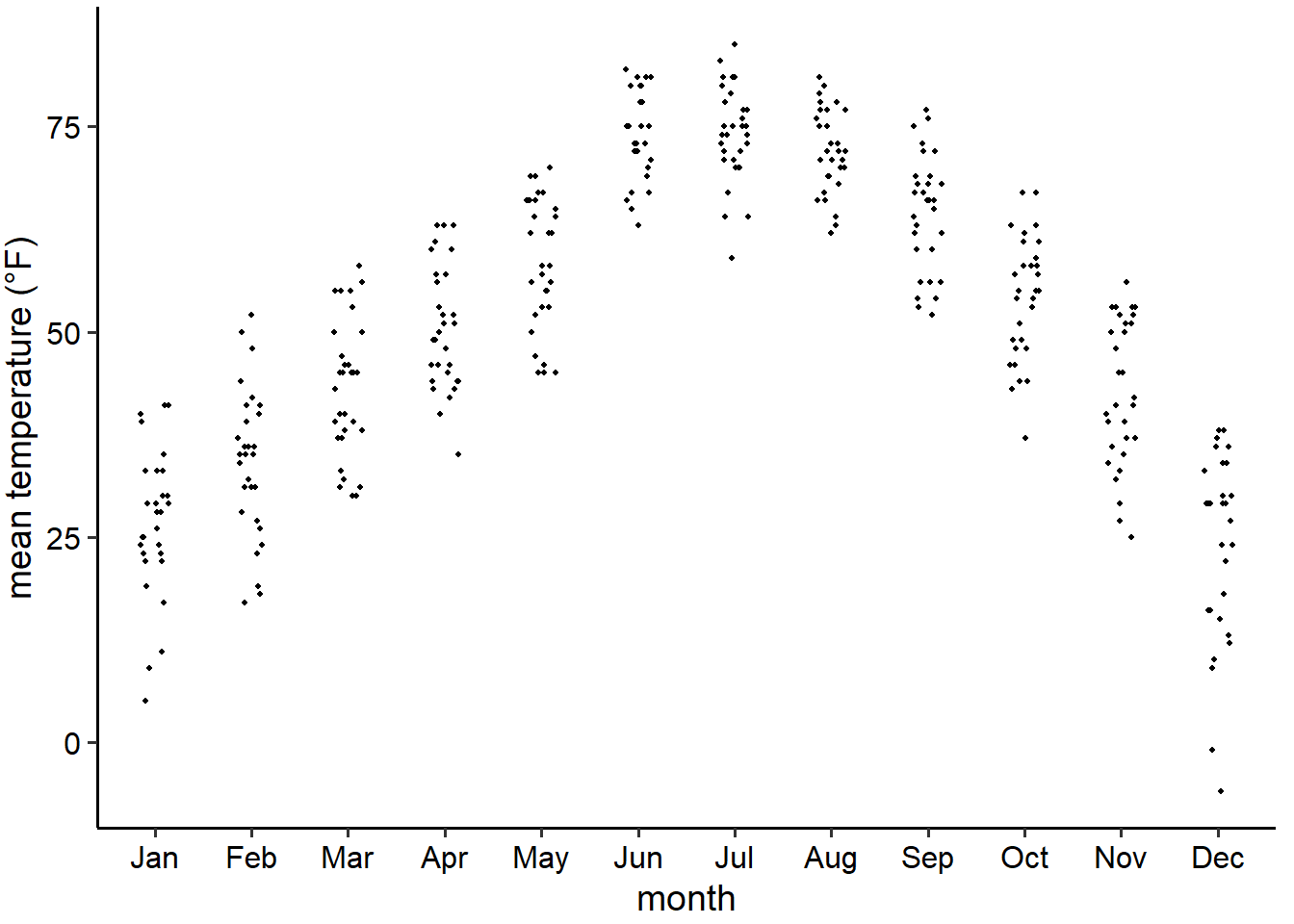
图 32.8: 林肯市2016年气温分布抖散图
于是,(小提琴图 + 抖散图)= sina 图,这样既可以看到原始的点,又可以看到统计分布,见图 32.9.
lincoln_sina <- lincoln_df %>%
ggplot(aes(x = month_short, y = `Mean Temperature [F]`)) +
geom_violin(color = "transparent", fill = "gray90") +
# dviz.supp::stat_sina(size = 0.85) +
geom_jitter(width = 0.25, size = 0.85) +
xlab("month") +
ylab("mean temperature (°F)") +
theme_classic(base_size = 14) +
theme(
axis.text = element_text(
color = "black",
size = 12
),
plot.margin = margin(3, 7, 3, 1.5)
)
lincoln_sina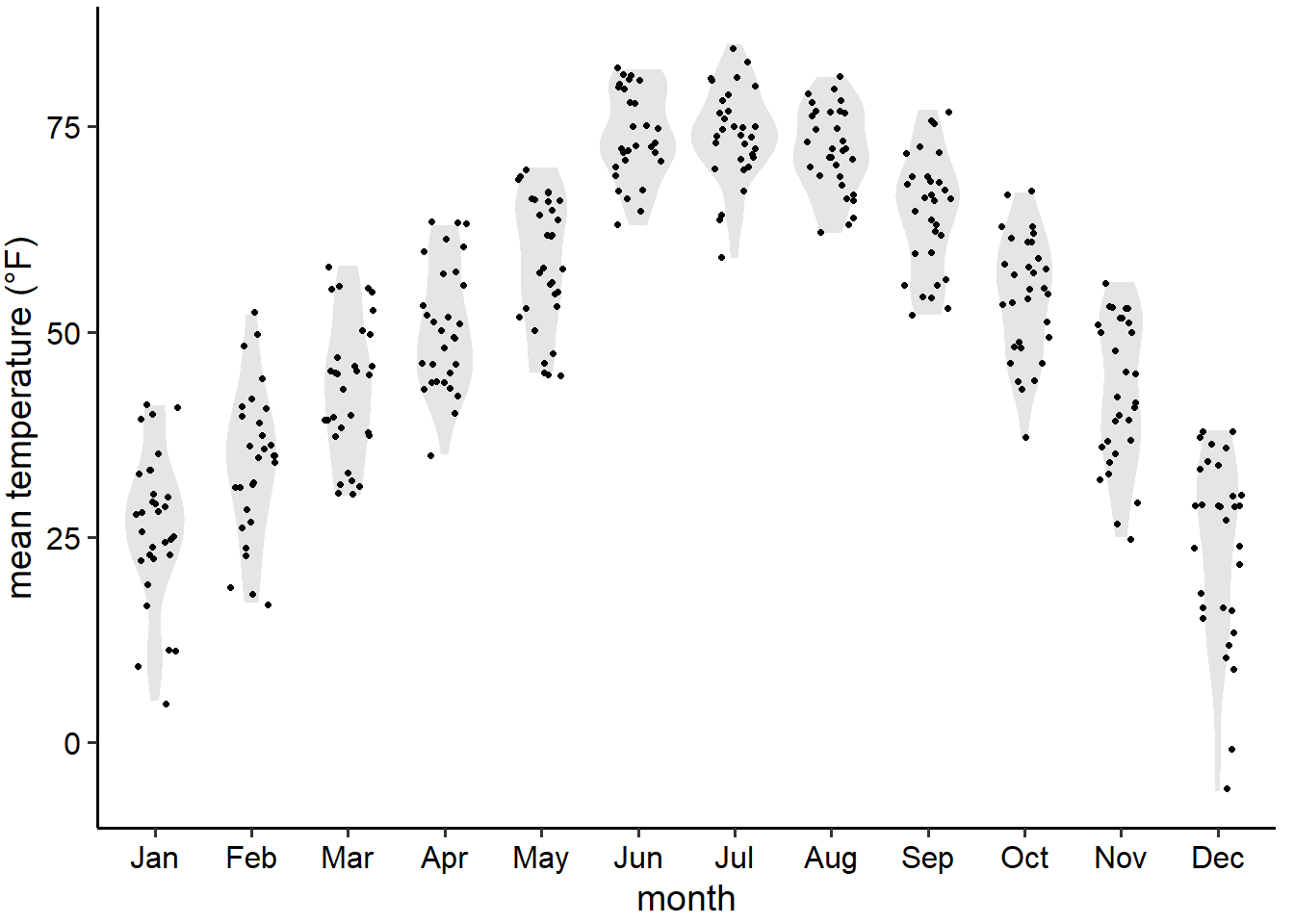
图 32.9: 林肯市2016年气温分布 sina 图
32.1.5 山峦图
前面的图,分组变量(月份)是顺着x轴,这里介绍的山峦图(重山叠叠的感觉)分组变量是顺着y轴,这种图,在画不同时间的分布图的时候,效果非常不错。 比如图 32.10, 展示气温分布的山峦图。同样,图中很直观地展示了11月份的气温分布有两个峰值。
bandwidth <- 3.4
lincoln_df %>%
ggplot(aes(x = `Mean Temperature [F]`, y = `Month`)) +
geom_density_ridges(
scale = 3, rel_min_height = 0.01,
bandwidth = bandwidth, fill = colorspace::lighten("#56B4E9", .3), color = "white"
) +
scale_x_continuous(
name = "mean temperature (°F)",
expand = c(0, 0), breaks = c(0, 25, 50, 75)
) +
scale_y_discrete(name = NULL, expand = c(0, .2, 0, 2.6)) +
theme_minimal(base_size = 14) +
theme(
axis.text = element_text(color = "black", size = 12),
axis.text.y = element_text(vjust = 0),
plot.margin = margin(3, 7, 3, 1.5)
)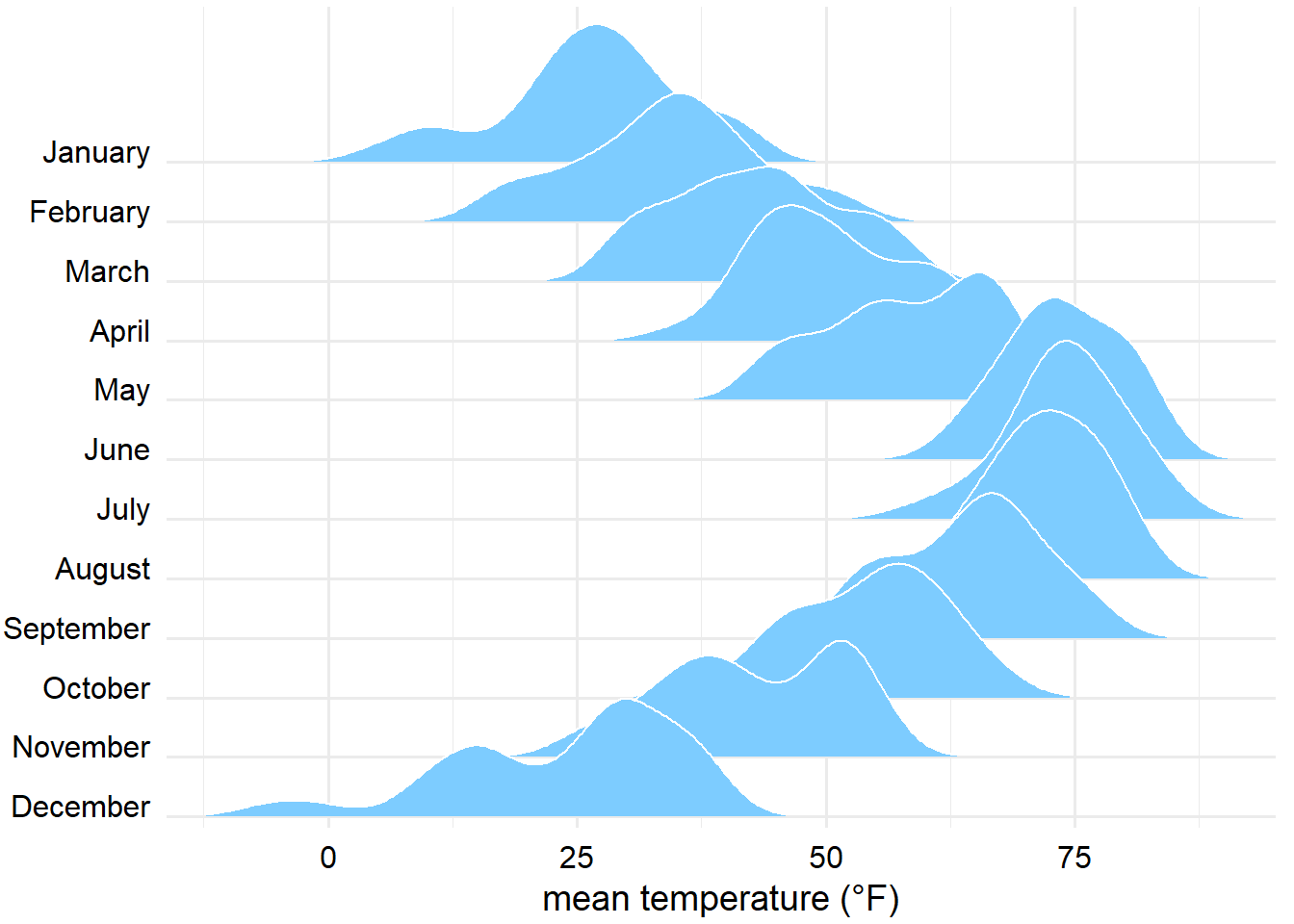
图 32.10: 林肯市2016年气温分布山峦图
但这种图,也有一个问题,y轴是分组变量,x轴是数据的密度分布,缺少了密度分布的标度(即,缺少了密度图的高度,事实上,小提琴图也有这个毛病),所以这种图不适合比较精确的密度分布展示,但在探索性分析中,比较不同分组的密度分布,可以很方便获取直观的认知感受。
32.1.6 有颜色山峦图
我们看到
- 温度值越高,x轴坐标越靠右;
- 温度值越高,颜色更亮;
因此,可以将气温变量映射到位置属性和颜色属性,见图 32.11
bandwidth <- 3.4
lincoln_base <- lincoln_weather %>%
ggplot(aes(x = `Mean Temperature [F]`, y = `Month`, fill = ..x..)) +
geom_density_ridges_gradient(
scale = 3, rel_min_height = 0.01, bandwidth = bandwidth,
color = "black", size = 0.25
) +
scale_x_continuous(
name = "mean temperature (°F)",
expand = c(0, 0), breaks = c(0, 25, 50, 75), labels = NULL
) +
scale_y_discrete(name = NULL, expand = c(0, .2, 0, 2.6)) +
colorspace::scale_fill_continuous_sequential(
palette = "Heat",
l1 = 20, l2 = 100, c2 = 0,
rev = FALSE
) +
guides(fill = "none") +
theme_minimal(base_size = 14) +
theme(
axis.text = element_text(color = "black", size = 12),
axis.text.y = element_text(vjust = 0),
plot.margin = margin(3, 7, 3, 1.5)
)
# x axis labels
temps <- data.frame(temp = c(0, 25, 50, 75))
# calculate corrected color ranges
# stat_joy uses the +/- 3*bandwidth calculation internally
tmin <- min(lincoln_weather$`Mean Temperature [F]`) - 3 * bandwidth
tmax <- max(lincoln_weather$`Mean Temperature [F]`) + 3 * bandwidth
xax <- axis_canvas(lincoln_base, axis = "x", ylim = c(0, 2)) +
geom_ridgeline_gradient(
data = data.frame(temp = seq(tmin, tmax, length.out = 100)),
aes(x = temp, y = 1.1, height = .9, fill = temp),
color = "transparent"
) +
geom_text(
data = temps, aes(x = temp, label = temp),
color = "black",
y = 0.9, hjust = 0.5, vjust = 1, size = 14 / .pt
) +
colorspace::scale_fill_continuous_sequential(
palette = "Heat",
l1 = 20, l2 = 100, c2 = 0,
rev = FALSE
)
lincoln_final <- cowplot::insert_xaxis_grob(lincoln_base, xax, position = "bottom", height = unit(0.1, "null"))
ggdraw(lincoln_final)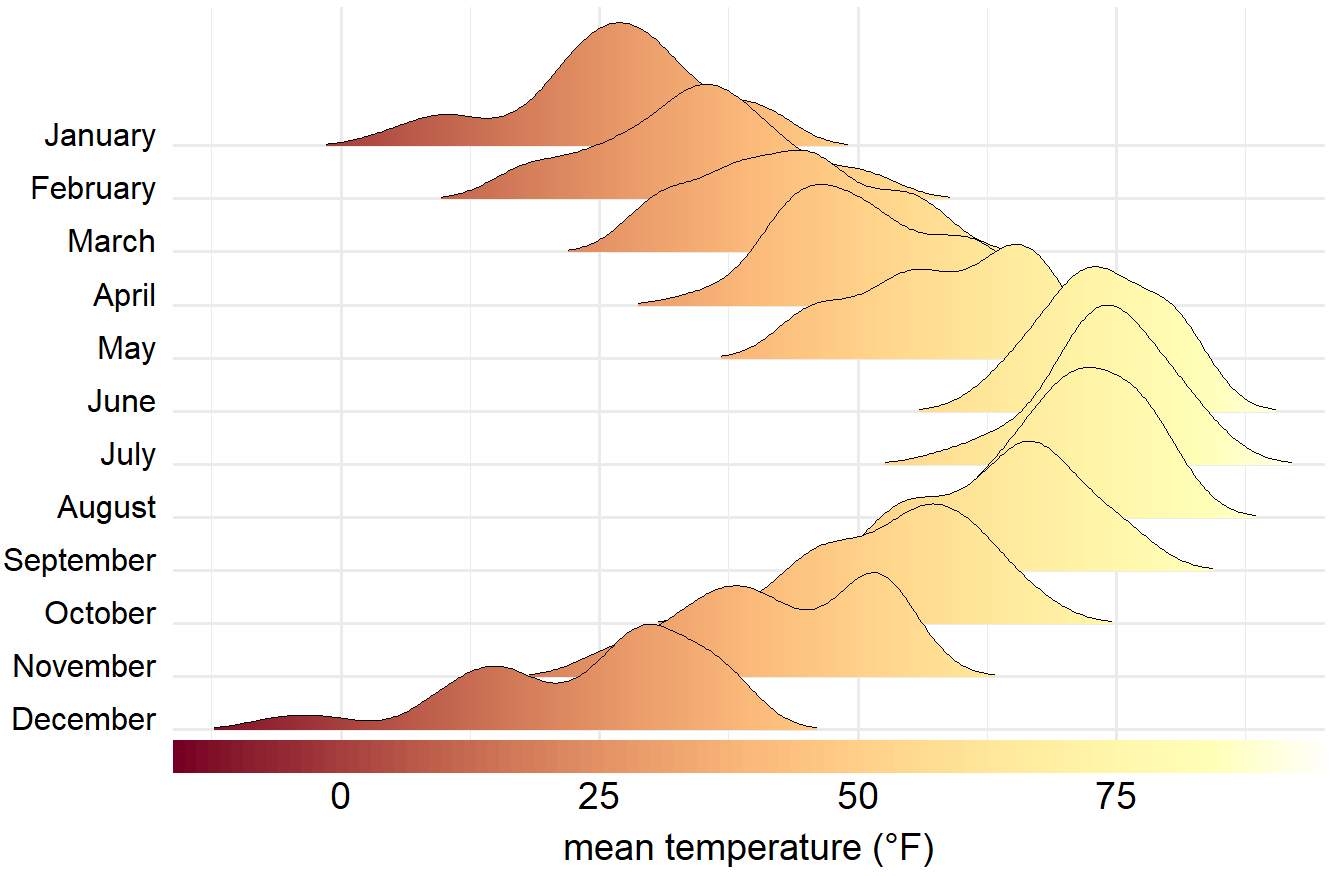
图 32.11: 林肯市2016年气温分布山峦图(颜色越亮,温度越高)
32.3 说明
本章的数据和代码来源于《Fundamentals of Data Visualization》的第9章和第20章。感谢Claus O. Wilke为大家写了这本非常好的书。
